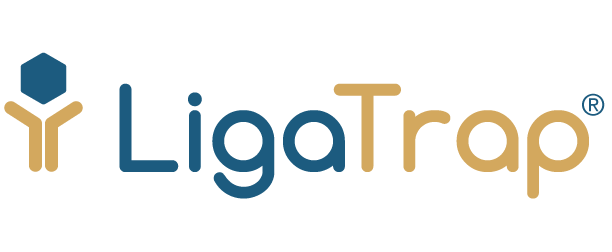LigaTrap Technologies’ versatile Base Resin is engineered to purify high quality antibodies from polyclonal and monoclonal sources. LigaTrap Base Resin is recommended for purifying IgG in a range of species as well as Human IgA and Chicken IgY applications. Kappa and Lambda IgG, IgA, and IgY may be purified using this product. LigaTrap Purification Resin is capable of processing and purifying monoclonal antibodies form cell culture supernatant, ascites fluid, hybridoma, and other sources of recombinant IgG, IgA, and IgY.
LigaTrap Base Purification Resin is capable of high yields and >95% purity, compared to Protein A and Protein G with yields below detection limit. It can reach up to 99% purity with additional processing.
| Base Resin Binding Capacities | ||
| Species | Antibody | Binding Capacity |
| Human | IgA | ≥15 mg / mL |
| IgG | ≥30 mg / mL | |
| Mouse | IgG | ≥20 mg / mL |
| Rat | IgG | ≥20 mg / mL |
| Llama | IgG | ≥15 mg / mL |
| Goat | IgG | ≥30 mg / mL |
| Rabbit | IgG | ≥25 mg / mL |
| Chicken | IgY | ≥15 mg / mL |
Base Resin – IgG Purification
Immunoglobulin G (IgG) Represents approximately 75% of serum antibodies as the most common type of antibody found in blood circulation. It is the most commonly researched and used in therapeutics of the various antibodies.
LigaTrap technology separates itself by having the highest quality chromatographic purification for IgG on the market today. The advantages LigaTrap IgG Resin include capture IgG subtypes, no immunogenicity or leaching, mild elution conditions, and can be reused after sanitization up to 100 times. LigaTrap Base Purification Resin is capable of processing and purifying monoclonal antibodies form cell culture supernatant, ascites fluid, hybridoma, and other sources of recombinant IgG.
Base Resin – Human IgA Purification
Immunoglobulin A (IgA) monoclonal antibodies have become increasingly favorable for their use as therapeutic tools, while remaining popular for their research and diagnostic applications. More IgA based therapeutics are being developed now than ever before due to a better understanding of the roles it plays in the immune system. In the past, IgA has been one of the more difficult antibodies to purify due to the lack of a robust and high capacity affinity resin.
With binding capacities of ≥15mg IgA/mL resin, LigaTrap Base Resin far exceeds the capacity of PierceTM Jacalin and other lectin-based resins commonly used. Additionally, LigaTrap Base Resin does not require the use of sugar (galactose, sucrose, etc.) based elution buffers, therefore simplifying further downstream processing. The resin binds both IgA1 and IgA2 subclasses.
LigaTrap technology separates itself by having the highest quality chromatographic purification for IgA on the market today. The advantages LigaTrap Base Resin include capture both heavy and light chain subtypes of IgA, no immunogenicity or leaching, mild elution conditions, and can be reused after sanitization up to 100 times. LigaTrap Base Purification Resin is capable of processing and purifying monoclonal antibodies form cell culture supernatant, ascites fluid, hybridoma, and other sources of recombinant IgA.
Product Descriptions
Purification kits are offered in microspin column, 1mL prepacked column, and 5mL prepacked column formats. Each kit includes the appropriate buffers and protocol for performing purifications.
Prepacked columns are offered in 1mL and 5mL formats for our affinity chromatography resins. Prepacked columns come in kit formats or as standalone products.
Loose resin is available in various volume sizes which can be packed for end user’s specific purification needs. For bulk resin orders larger than 100mL, please inquire.
This product is not recommended in serum purification applications due to cross-reactivity with other immunoglobulins. Please consult LigaTrap for protocols that may improve results in serum.
| Part # | Name | Amount | Price | |
| LT-150KIT | Base Resin Microspin Column Kit w/ Buffers |
KIT-10x0.1 mL | $355.00 | Add to Cart |
| LT-150-1mL KIT | Base Resin 1mL Prepacked Column Kit w/ Buffers |
KIT-1x1 mL | $281.00 | Add to Cart |
| LT-150-5mL KIT | Base Resin 5mL Prepacked Column Kit w/ Buffers |
KIT-1x5 mL | $1,001.00 | Add to Cart |
| LT-150 | Loose Base Resin – 5mL |
5 mL | $543.00 | Add to Cart |
| LT-150-10mL | Loose Base Resin – 10mL |
10 mL | $862.00 | Add to Cart |
| LT-150-25mL | Loose Base Resin – 25mL |
25 mL | $1,101.00 | Add to Cart |
| LT-150-50mL | Loose Base Resin – 50mL |
50 mL | $1,604.00 | Add to Cart |
| LT-150-100mL | Loose Base Resin – 100mL |
100 mL | $2,014.00 | Add to Cart |
| LT-150-MSC | Base Resin Microspin Columns without Buffers |
10x0.1 mL | $152.00 | Add to Cart |
| LT-150-1x1mL | Base Resin Prepacked Column – 1mL |
1x1 mL | $130.00 | Add to Cart |
| LT-150-1x5mL | Base Resin Prepacked Column – 5mL |
1x5 mL | $585.00 | Add to Cart |
| LT-150-3x1mL | Base Resin Prepacked Columns – 3x1mL |
3x1 mL | $366.00 | Add to Cart |

